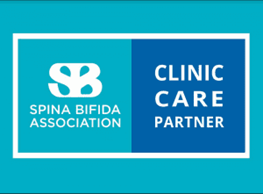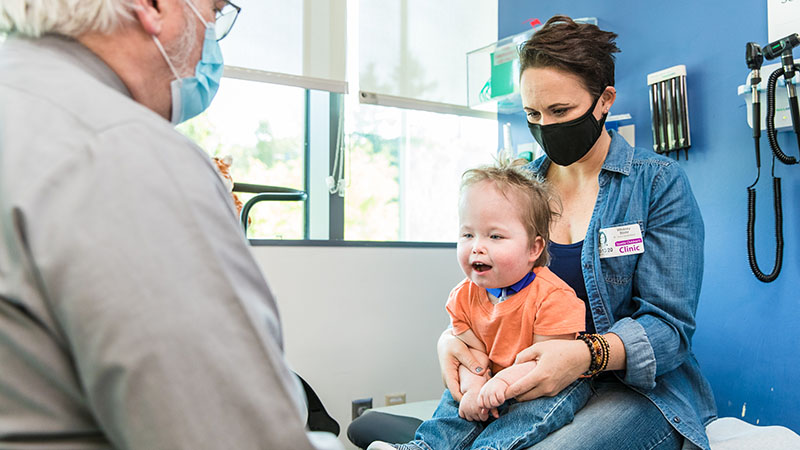Spina Bifida
Contact the Spina Bifida Program
What is spina bifida?
Spina bifida (SB) happens when the neural tube, which forms the brain and spine of the , does not close completely as the fetus develops. This is called a . It happens during the first month of pregnancy, often before anyone knows they are pregnant.
There are many forms of neural tube defects, and they vary greatly in how they affect a child. Some, such as , cause few or no problems. In other forms, the spinal cord develops outside the body, leaving it open and unprotected. The most severe form is myelomeningocele. It causes loss of muscle use (paralysis) in the legs, bowel and bladder, along with learning disabilities.
What causes spina bifida?
Doctors do not know the exact cause. Research suggests that and nutrients during pregnancy play a role. To help prevent spina bifida, all women who might become pregnant should take daily. This B vitamin helps the baby’s neural tube grow properly into the brain and spinal cord. Women who have had a baby with spina bifida should take higher doses of folic acid to prevent the condition in future pregnancies.
Types of spina bifida
Our Spina Bifida Program cares for babies, children, teens and young adults with all forms of SB. These include:
- Caudal regression syndrome: Also called sacral agenesis or CRS. The lower (caudal) part of the spine does not form correctly before birth. This can cause problems in many parts of the lower body, such as the lower back and legs, urinary tract, genitals and digestive system.
- Diastematomyelia: In this neural tube defect, the spinal cord splits into 2 cords near the end.
- Lipomyelomeningocele: A fatty mass attaches to the spinal cord and may slowly pull on it. If not treated, it can lead to nerve damage and loss of function.
- Meningocele: In this moderate form of SB, as a fetus grows the fluid-filled sac that surrounds the spinal cord forms outside of the body in the spine area. The sac does not contain the spinal cord or nerves.
- Myelocystocele: Before birth, the spinal cord pokes through part of the spine bones into a sac filled with . Unless repaired early in life, this can cause problems with your child’s mobility, bowel and bladder function or sensation.
- Myelomeningocele (MMC): In this most serious form of SB, part of the spinal cord sticks through a gap in the bones of the back as the fetus develops. This leaves the spinal cord open and unprotected.
- Myeloschisis: In this severe form of spina bifida, the spinal cord and surrounding nerve tissue are exposed to as the fetus grows during pregnancy. This may affect your child’s mobility, bowel and bladder function or sensation.
Spina Bifida Care at Seattle Children's
Outlook for babies born with spina bifida
Spina bifida is present at birth. How serious the condition is may only be clear as your child grows and develops. Each child is different.
Some forms of spina bifida may affect your child’s mobility, bowel and bladder function or sensation.
Some children have other complex problems, such as spinal deformities, problems with how the lower part of the body develops, hydrocephalus, tethered spinal cord, Chiari malformation or syringomyelia.
Developmental conditions that affect some children with spina bifida include , autism, and ADHD.
What are the symptoms of spina bifida?
Symptoms of spina bifida vary widely, based on the type your child has. Children with mild forms may have no symptoms. With severe forms, routine tests during pregnancy may show problems with how the fetus is developing.
At birth, a baby may show symptoms like dimpling of the skin on their back or a lump under the skin.
Later in childhood, problems may happen over time. These can affect your child’s movement, sensation, strength or bowel and bladder control.
How is spina bifida diagnosed?
With more severe forms, spina bifida may be diagnosed during pregnancy check-ups on an scan or with blood tests or .
Your doctor may refer you to our Fetal Center. Our team will check your baby’s health and do such as and ultrasound. After a full assessment, we will advise you on what to expect and help you prepare for the care your baby will need.
Less severe types of spina bifida may not be diagnosed until after birth. Signs may include a dimple on your baby’s lower back, usually above the buttocks (sacral dimple). Your baby’s primary care team can help decide if your baby needs more evaluation.
Later in childhood, doctors may diagnose spina bifida in a child because of symptoms like weakness, poor sensation, changes in the legs and feet or problems with bowel and bladder control. An MRI can help diagnose the condition.
How is spina bifida treated?
If a severe form of spina bifida is diagnosed during pregnancy, our Fetal Center team will work with your birth hospital to plan for a safe delivery and the special care your baby will need at birth. Our team will arrange your baby’s safe transfer to Seattle Children’s after they are born.
Babies with severe forms like myelomeningocele (MMC) will need surgery to repair the spinal cord defect during pregnancy or in the first days of life. In moderate types of SB, like lipomyelomeningocele, we can surgically repair it later, because the spinal cord is not open and unprotected.
Surgery — if needed — is just the first step in your child’s treatment.
Our Spina Bifida Program provides coordinated care from birth through 21 years for children with all forms of neural tube defects. We will tailor treatment for your child and family. Depending on their needs, your child may receive care from experts in Neurodevelopment, Neurosurgery, Nutrition, Orthopedics, Rehabilitation Medicine, Urology, Reconstructive Pelvic Medicine, Gastroenterology and Social Work.
Our team will be with your family along this journey. Each child is unique and will show us what they can do over time. Our dedicated spina bifida care coordinator helps ease your child’s care management: scheduling SB-related appointments, informing you of next steps, connecting you with resources for your family and working with therapists and schools in your community.
Surgery to Repair Spina Bifida
If your child has a severe form of spina bifida and you choose to have fetal surgery during pregnancy, we will coordinate care with the hospital of your choice.
If your baby will need surgery to repair their spinal defect in their first days or weeks of life, we work closely with your birth hospital and are national leaders in safely moving fragile newborns. The neurosurgeons and plastic surgeons work as a team to repair the neural tube defect. This:
- Protects the spinal cord
- Limits the risk of infection
- Prevents more damage to the spinal cord but does not restore damaged nerves
Our Level IV (4) Neonatal Intensive Care Unit (NICU) team is skilled and equipped to care for the sickest newborns.
Treating Related Conditions
Children with some forms of spina bifida have other conditions that need treatment, such as:
- Hydrocephalus, where too much collects in their head and puts pressure on their brain. Most often, neurosurgeons place a tube (called a shunt) in the skull to drain CSF to another part of the body, where it is absorbed.
- Tethered spinal cord, where the is pulled down and stuck to the instead of floating freely inside it. Any differences in the spinal column or spinal cord increase the risk of tethered cord.
- Chiari malformation, a problem with the way parts of the brain are shaped and how they sit in the skull. Parts of the brain hang down through the opening in the base of the skull into the upper neck.
- Syringomyelia, a cyst in the center of the spinal cord that is filled with fluid. This can put pressure on the spinal cord and cause nerve damage.
Spina Bifida Care Until Adulthood
Our spina bifida team will design a treatment plan just for your child. Experts from many specialties will work together to help your child thrive at home, in school and in your community.
- We hold clinics twice a month at Seattle Children’s hospital campus and provide many services at our clinics in Bellevue and Federal Way.
- We follow best practices and treat your whole child, not just their medical needs. Having Neurodevelopmental Pediatrics as the home for our Spina Bifida program helps us attend to your child’s overall development.
- If your child has mobility issues, our Orthopedics, Orthotics and Rehabilitation Medicine specialists will work to meet their needs. Treatment options include orthopedic surgery, physical therapy, occupational therapy and medical devices like braces, crutches or wheelchairs.
- Some children born with spina bifida have differences in their legs, feet, hips or spine. Your child may have orthopedic surgery for problems like clubfoot, curved spine (scoliosis), contracted muscles or dislocated hips.
- Most children with MMC and other severe forms of spina bifida develop and need a shunt. Our Neurosurgery team will keep watch over your child to make sure the shunt keeps working well all during childhood.
- In many kids with spina bifida, their bladder does not work normally, because their spinal cord and the nerves that control the bladder did not form correctly before birth. This can affect how their kidneys work, their ability to pee and their quality of life. Seattle Children’s takes part in a nationwide study (UMPIRE) to assess the best ways to manage bladder and kidney issues for newborns and young children with SB.
- To address bowel and bladder issues, your child may see specialists in Neurodevelopment, Rehabilitation Medicine, Reconstructive Pelvic Medicine, Gastroenterology or Urology.
- As they reach adulthood, we help your child transition to a provider who cares for adult patients.
Why choose Seattle Children's for spina bifida care?
Out of all the priceless gifts our care teams have given us, there’s one that sustains us: the simple belief that our son has boundless potential.
— Whitney Stohr, mom of Malachi, who was diagnosed with myelomeningocele during pregnancy. Today, he’s thriving.
Read Malachi’s story.

- Seattle Children’s has been a leader for over 50 years in providing complete, coordinated care for children with spina bifida. We have been named as a Clinic Care Partner by the Spina Bifida Association (SBA), the national leader in providing research, education, support, clinical care and advocacy to all those affected by SB.
- If spina bifida is diagnosed during pregnancy, specialists at our Fetal Center will assess your baby’s health and help prepare for their birth and care.
- Our Spina Bifida Program cares for children born with SB from birth through 21 years of age. We customize your child’s treatment plan to meet their medical and developmental needs over the long term.
- Our team follows over 600 children with spina bifida and related disorders. Many require regular follow-up with other medical specialties. Our team includes experts in Neurodevelopment, Neurosurgery, Nutrition, Orthopedics, Rehabilitation Medicine, Urology and Social Work.
- Your child will benefit from innovations developed at Seattle Children’s to make treatments safer and more effective. Our patients have the option to take part in clinical trials of promising new therapies. Learn about participating in clinical trials at Seattle Children’s.
Contact Us
If you would like an appointment, ask your child’s primary care provider to refer you to our Neurodevelopmental Program, which includes the Spina Bifida Program.
If you have a referral, call 206-987-2210 to make an appointment.
Providers, see how to refer a patient for Neurodevelopmental care.
Paying for Care
Learn about paying for care at Seattle Children’s, including insurance coverage, billing and financial assistance.


